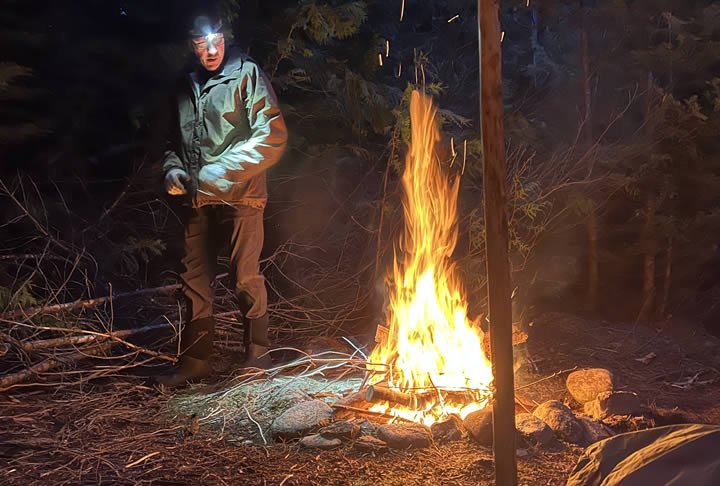How we break down or categorize survival situations is important to help in our understanding of survival. We break down survival situations to categorize and study them more in-depth. It also helps in our preparation for any potential survival situations. In modern wilderness survival we break them down as; Short-Term Survival Situations (1 to 4 Days), Medium-Term Survival Situations (5 to 25 Days) and Long-Term Survival Situations (26 Days Plus). Each of these types of survival situations will have their own challenges and solutions. This means you need to develop skills for all three, although Short-Term situations must take up most of your initial training time since they are the most numerous and if you do not survive the first few days, you are dead.
Types of Survival Situations
1) Short-Term Survival Situations (One to four days)
2) Medium-Term Survival Situations (Five to 25 days)
3) Long-Term Survival Situations (26 days plus)
Short-Term Survival Situations

Short-term survival situations are one to four days long. The most common being three days or two-nights long if an individual or group a searched and rescue need to initiate for them. A rescue or retrieval from the wilderness is often less than 24 hours since you are only required to be picked up or rescued from a known location. This requires a beacon or similar retrieval system or an advanced route planning and safety system to achieve. Short-term situations make up 99 percent of all survival situations.
Therefore survival situations more than four days long are rare. Most end in a rescue and in a few rare cases the death of the individuals involved. Either way training and the choice of equipment should concentrate on getting an individual or group stranded in the wilderness through those first few days and then giving them the knowledge they needed to survive through the first few days of a medium-term situation.
Medium-Term Survival Situations
Medium-term survival situations are five to 26 Days long. Fasting is an excellent medium-term survival strategy as fasting for 20 days normally causes little damage to your body. Beyond 20 days of fasting, our bodies begin to damage themselves due to loss of muscle mass and a lack of essential vitamins and minerals. So beyond 25 days, fasting as a survival strategy begins to damage your body, just like any other form of self-induced starvation.
These survival situations are very rare. They seldom last longer than ten days. Canada’s dwindling wild lands, modern search and rescue resources, along with cell phones, satellite phones and beacons have reduced the chances of getting stranded for this length of time.
To get stranded in a medium-term survival situation two things are generally needed: one, you need to have done no planning or very poor planning, and two, you need to have had bad luck. Beyond food, preparation for a short-term and medium-term survival situation is much the same, except you can rarely survive without actual survival skills. This means understanding, learning and practicing true survival skills along with an in-depth knowledge of survival physiology and psychology.
Long-Term Survival Situations
Long-term survival situations are 26 days or more in length and they are extremely rare. To get into one, you need to flee civilization and attempt not to be found. This means you put yourself into this situation. Mostly by underestimating how hard it is to live in the wilderness over the long term. Then discovering at some point that you are forced to change from living in the wilderness as planned, to surviving in that survival environment.
Modern Wilderness Survival training generally does not delve much into long-term survival techniques, we leave that to the practisers of primitive technology or specific instructors to discuss and properly teach each of the appropriate skill sets separately. These separate skills sets are numerous and include but are not limited to; bushcraft, hunting, trapping, fishing, tracking, edible plant identification and forging, cooking, long term food storage, wilderness first aid, medicinal plant identification and forging and wilderness navigation.
Remember, survival over 26 days is almost always a lifestyle choice or the result of a specific decision to live in the 'wilderness.' Normally these start with someone heading out alone hoping to thrive and 'live of the land' and end in either starvation or rescue.
In the wilderness individuals rarely survive over the long term without the support of an extended family group. Read about Christopher McCandless's attempt to survive alone in Alaska and his legacy in the survival training community.
Why we Survive?
These three categories of survival situations will all have their own challenges and solutions. Remember it will be basic wilderness survival skills which allow us to survive in the wilderness when stranded, not the ability to brain tan, make baskets or even lighting a fire by friction. This means learning wilderness survival skills first, then adding on the other long term survival skills one at a time.
Survival Resources
- Survival Core Seminar [Suggested Survival Training]
- BWI's 15 Critical Items [Suggested Equipment List]
- Survival Kit in a Pot [Basis of a Great Survival Kit]
- Survival Kit in a Water Bottle [Light Alternative Survival Kit]

